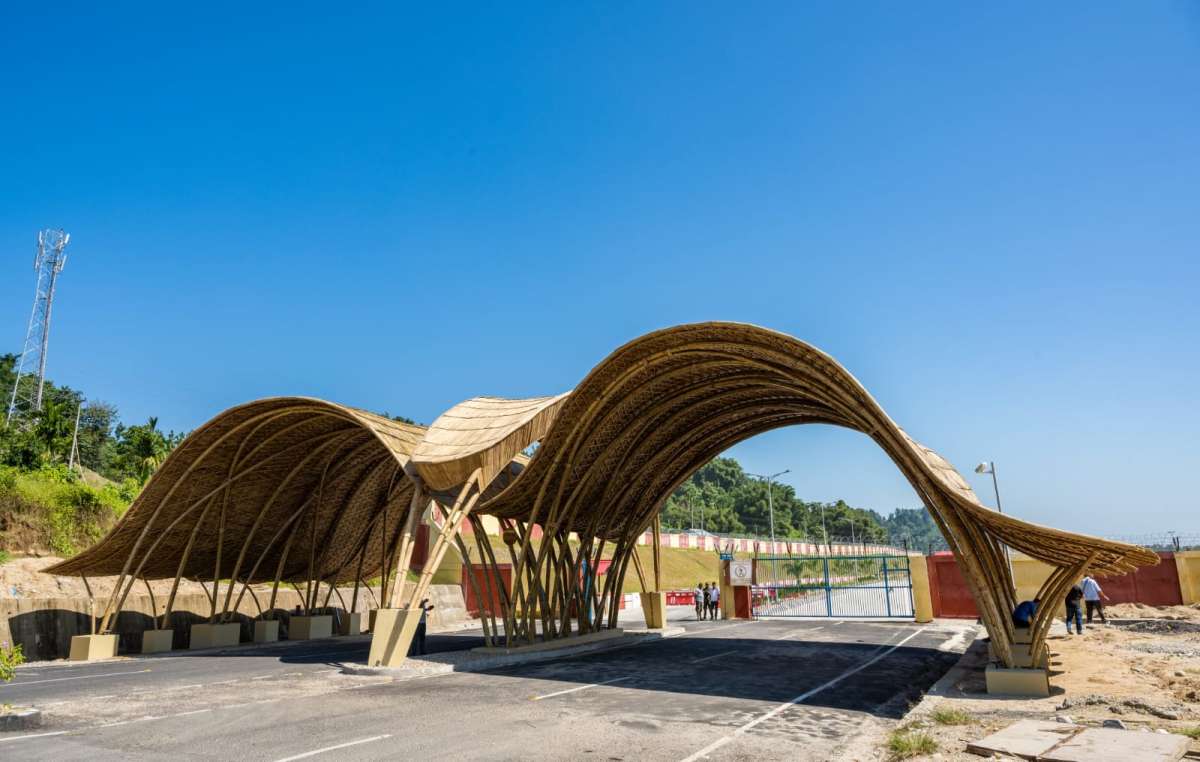Arunachal Pradesh occupies a very unique geographical zone in the northeast region of India. Since it is a landlocked region with mountains, forests and rivers on all sides, it has been in relative isolation for many years which posing a great challenge to the people living there. So, it was big news when a new airport was announced in the state.
Donyi Polo Airport will be the first airport in the state capable of servicing long-range commercial flights. When our company was approached to design and build a gate for the airport, we were very excited about the opportunity. It gave us a great sense of pride to be able to build such a landmark structure for our people.
Also Read: Easy Guide To Choose A Color Palette For Your Space
One of the biggest challenges faced was that the construction timeframe was during the monsoons, and Arunachal Pradesh is known to receive a significantly high amount of rainfall. We overcame this challenge by prefabricating parts of the structure offsite in a covered location which ensured systematic and timely production of all requirements. Due to our smart planning, the structure was completed 5 months before the scheduled delivery date for the project.

The inspiration behind the design
Airports represent flight and the first aeroplanes were inspired by the flight of birds. The Great Hornbill is the state bird of Arunachal Pradesh – it is a unique bird with very distinct features, and it served as the perfect inspiration for the design of the gate.
All aspects of the Great Hornbill were studied – its features, form and flight. Some of its most striking characteristics are its beak, its majestic body and its massive wingspan. These features were incorporated into the design of the gate. With the wings spanning across the entry and exit roads, the gate has been designed as a double-headed Great Hornbill so that people entering and existing the airport are greeted by this majestic bird.
Also Read | Interior stylist Bhawana Bhatnagar on smart lockers at residential spaces
By chosing the Great Hornbill as an inspiration for the entry gate designing the entry gate to the new Donyi Polo airport, we hoped to instill a sense of pride among the locals for their culture and tradition.
Materials used to construct the gate
While building such a landmark structure, it was also important to consider the materials to be used. Arunachal Pradesh is rich in biodiversity with many types of cane and bamboo. We wanted the design and materials to be locally inspired and sourced. Since bamboo and cane are synonyms with strength and durability, they were the perfect choice of material for the structure.
Also Read | Interior stylist Bhawana Bhatnagar on smart lockers at residential spaces
The gate is built entirely from the best quality bamboo and cane from Arunachal Pradesh. The process of building with these materials started with selection. Healthy groves were identified and only bamboo which was four years old was harvested. We chose two types of bamboo – Bambusa tulda (jati bamboo) for the roofing and Bambusa balcooa (baluka) for the arches and main structure. Once the bamboo was harvested, it was then treated and preserved with non-toxic salts such as borax and boric acid powder to increase its lifespan by several decades.
Manpower involved
It took 15 local artisans working full-time to complete this project, all of whom specialised in working with these materials. They managed the entire process from harvest and treatment to prefabrication and construction of the final structure and were able to shape and mould it with complete ease and confidence. Without their support and expertise, this project would not have been possible.
About Studio Aro
We started Studio Aro in 2018 to establish a practice which would focus solely on bamboo and sustainable architecture. Since the industry for permanent bamboo architecture is still very nascent, we wanted to make a mark on this movement and contribute to the growth and adoption of sustainable architecture in the world.
The process of establishing our studio was not limited only to projects but also towards developing the whole value chain of bamboo production right from cultivation and harvest to treatment and application. If we want to deliver long-lasting permanent structures to our clients, we have to ensure that only the best quality materials are used.
Also Read | 5 Innovative ways to incorporate Japanese architectural elements in the Indian home decor
We have done multiple projects to date in diverse regions such as Tamil Nadu and Nagaland. Since the process of construction takes a minimum of several months, it is always a pleasure to work in new environments and understand the local culture. To be honest, one of the most significant aspects of using natural materials such as bamboo and cane is how they benefit the local economy. We often work with local artisans and this allows them to practice their traditional crafts and continue to earn a livelihood from it. One of our key aims is to keep these arts alive.
Also Read | 5 Innovative ways to incorporate Japanese architectural elements in the Indian home decor
At Studio Aro, we are a team of dedicated designers and builders who stay true to our roots. Since we belong to the lush forested areas of northeast India, we have a deep connection with nature. Bamboo is our speciality and material close to our hearts. As an art form, it has been passed on to us through the generations. We build with our hands. We weave and create. We are proud of our skills and look forward to sharing them with the world and contributing to the sustainable architecture movement.
Project name: The Great Hornbill Gate of Donyi Polo Airport
Area: 2500 sq. ft.
Materials used: Bamboo and cane
Dimension of the structure: 23 feet tall and 82 feet wide